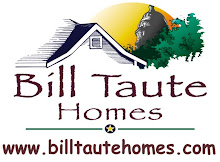
Green Building is a measure of several building initiatives including site planning, energy efficiency, resource/material efficiency, water conservation, indoor air quality, and homeowner education. The home must be designed and built to perform as a system, taking all of these performance characteristics into account, and must perform against specific performance standards. The performance is measured against the requirements of local and national green building programs. It is up to the Builder and the Home Buyer to determine which of these issues are of the greatest concern to them, and which make the most sense to include in a new home from a cost and benefit perspective. While there are numerous Green Building techniques and practices, there are more opinions about which techniques and practices are the most beneficial to the
 Home Buyer, and to the environment. Over the next few weeks, I will attempt to analyze several of these practices that Bill Taute Homes has adopted over the years, and possibly re-visit some of the practices that we have used in the past to help future Home Buyers determine which choices make sense for their new home.
Home Buyer, and to the environment. Over the next few weeks, I will attempt to analyze several of these practices that Bill Taute Homes has adopted over the years, and possibly re-visit some of the practices that we have used in the past to help future Home Buyers determine which choices make sense for their new home.The first subject I will address is Optimum Value Engineering.
Optimum Value Engineering (OVE) refers to framing techniques that reduce the amount of lumber used to build a home while maintaining the structural integrity of the building. Using OVE techniques results in lower material and labor costs and improved energy performance for the building. While traditional framing crews may not initially save any labor cost on the construction of the home as they become familiar with OVE practices, the simple fact that there will be less waste produced from less lumber will produce a small labor savings during the waste management portion of the project. Bill Taute Homes builds primarily on inner city lots with multiple restrictions, setbacks, and limitations, so we haven't been able to implement 100% of the OVE practices, but with the guidance of our structural engineer, Tim Zhang of Green Earth Engineering, we have been able to implement the following in our latest projects: (1) Increasing wall stud spacing from 16" to 24". (2) Spacing floor joists, rafters, floor trusses, and roof trusses at 24" instead of 16" by aligning with stud framing such that loads are transferred directly. (3) Sizing door and window headers correctly, and eliminating headers in non-load bearing conditions. (4) Using 2 studs at corners instead of 3 studs.
A study conducted by the National Association of Home Builders Research Center (NAHBRC) found that OVE methods saved $0.24 to $1.20 per square foot in framing wood compared with conventionally built houses (NRDC, "Efficient Wood Use in Residential Construction," 1998). It is important to note that the public is generally unaware of how much wood and labor goes into conventionally framed wood homes, so educating future and current home buyers about this process will hopefully help them appreciate the economic benefits of OVE.


Bill, When you are spacing roof truss/rafters at 24" are you using 5/8" or 3/4" decking? What's your opinion on those greater spaces in regards to flex of finished material (roof, stucco, siding, etc). Great blog my friend. Looking forward to reading more!
ReplyDeleteMatt, on my home at Mueller, I used the Zip Wall and Zip Roof system for the first time, and it will probably be one of the next items I review here. While this product only uses a 7/16" OSB panel, it seems like the waterproof covering actually acts to stabilize the panels, and I haven't seen any problems with the flex in the greater spacing, with one exception. We have a 1/2"/12" pitch on an awning roof, that we plan to build a 4' wide walkway deck, to our detached Studio, over the TPO roofing, and it is a little flexible right now. However, using the same OVE concepts, we will place our decking sleepers directly over the framing members below to stabilize the composite decking on the walk and I anticipate no problems. Thanks for your comments, and thanks for luring me into the Blog world.
ReplyDelete